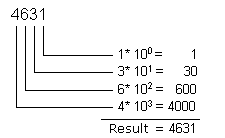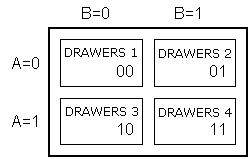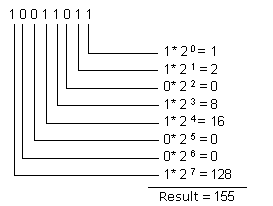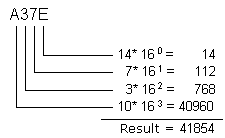Numerical Systems
Introduction
It was always difficult for people to accept the fact that some things differ from them or their way of thinking. That is probably one of the reasons why
numerical systems which differ from a decimal are still hard to understand. Still, whether we want it or not, reality is different. Decimal
numerical system that people use in everyday life is so far behind the binary system used by millions of computers around the world.
Each numerical system are based on some basis. With a decimal numerical system, that basis is 10, with binary 2, and with a hexadecimal system 16. The value of each decimal is determined by its position in relation to the whole number represented in the given
numerical system. The sum of values of each decimal gives the value of the whole number. Binary and hexadecimal
numerical systems are especially interesting for the subject of this book. Beside these, we will also discuss a decimal system, in order to compare it with the other two. Even though a decimal
numerical system is a subject we are well acquainted with, we will discuss it here because of its relatedness to other
numerical systems.
Decimal numerical system
Decimal numerical system is defined by its basis 10 and decimal space that is counted from right to left, and consists of numbers
0,1, 2, 3, 4, 5, 6, 7, 8, 9. That means that the end right digit of the total sum is multiplied by 1, next one by 10, next by 100, etc.
Example:

Operations of addition, subtraction, division, and multiplication in a decimal numerical system are used in a way that is already known to us, so we won't discuss it further.
Binary numerical system
Binary numerical system differs in many aspects from the decimal system we are used to in our everyday lives. Its
numerical basis is 2, and each number can have only two values, '1' or '0'. Binary
numerical system is used in computers and microcontrollers because it is far more suitable for processing than a decimal system. Usually, binary number consists of binary
digits 8, 16 or 32, and it is not important in view of the contents of our book to discuss why. It will be enough for now to adopt this information.
Example:
10011011 binary number with 8 digits
In order to understand the logic of binary numbers, we will consider an example. Let's say that we have a small chest with four drawers, and that we need to tell someone to bring something from one of the drawers to us. Nothing is more simple, we will say left side, bottom (drawer), and the desired drawer is clearly defined. However, if we had to do this without the use of instructions like left, right, beneath, above, etc., then we would have a problem. There are many solution to this problem, but we should look for one that is most beneficent and practical! Lets designate rows with A, and types with B. If A=1, it refers to the upper row of drawers, and for A=0, bottom row. Similarly with columns, B=1 represents the left column, and B=0, the right (next picture). Now it is already easier to explain from which drawer we need something. We simply need to state one of the four combinations: 00, 01, 10 or 11. This characteristic naming of each drawer individually is nothing but binary numerical representation, or conversion of common numbers from a decimal into binary form. In other words, references like "first, second, third and fourth" are exchanged with "00,01, 10 and 11".

What remains is for us to get acquainted with logic that is used with binary
numerical system, or how to get a numerical value from a series of zeros and ones in a way we can understand, of course. This procedure is called conversion from a binary to a decimal number.
Example:

As you can see, converting a binary number into a decimal number is done by calculating the expression on the left side. Depending on the position in a binary number, digits carry different values which are multiplied by themselves, and by adding them we get a decimal number we can understand. Let's further suppose that there are few marbles in each of the drawers: 2 in the first one, 4 in the second drawer, 7 in the third and 3 in the fourth drawer. Let's also say to the one who's opening the drawers to use binary representation in answer. Under these conditions, question would be as follows: "How many marbles are there in 01?", and the answer would be: "There are 100 marbles in 01." It should be noted that both question and the answer are very clear even though we did not use the standard
terms. It should further be noted that for decimal numbers from 0 to 3 it is enough to have two binary digits, and that for all values above that we must add new binary digits. So, for numbers from 0 to 7 it is enough to have three digits, for numbers from 0 to 15, four, etc. Simply said, the biggest number that can be represented by a binary digit is the one obtained when basis 2 is graded onto a number of binary digits in a binary number and thus
obtained number is decremented by one.
Example:
This means that it is possible to represent decimal numbers from 0 to 15 with 4 binary digits, including numbers '0' and '15', or 16 different values.
Operations which exist in decimal numerical system also exist in a binary system. For reasons of clarity and legibility, we will review addition and subtraction only in this chapter.
Basic rules that apply to binary addition are:

Addition is done so that digits in the same numerical positions are added, similar to the decimal
numerical system. If both digits being added are zero, their sum remains zero, and if they are '0' and '1', result is '1'. The sum of two ones gives
two, in binary representation it will be a zero, but with transferring '1' to a higher position that is added to digits from that position.
Example:

We can check whether result is correct by transferring these number to decimal
numerical system and by performing addition in it. With a transfer we get a value 10 as the first number, value 9 as the second, and value 19 as the sum. Thus we have proven that operation was done correctly. Trouble comes when sum is greater than what can be represented by a binary number with a given number of binary digits. Different solutions can be applied then, one of which is expanding the number of binary digits in the sum as in the previous example.
Subtraction, like addition is done on the same principle. The result of subtraction between two zeros, or two ones remains a zero. When subtracting
one from zero, we have to borrow one from binary digit which has a higher value in the binary number.
Example:

By checking the result as we did with addition, when we translate these binary numbers we get decimal numbers 10 and 9. Their difference corresponds to number 1 which is what we get in subtraction.
Hexadecimal numerical system
Hexadecimal numerical system has a number 16 as its basis. Since the basis of a
numerical system is 16, there are 16 different digits that can be found in a hexadecimal number. Those digits are "0, 1, 2, 3, 4, 5, 6, 7, 8, 9, A, B, C, D, E, F". Letters A, B, C, D, E and F are nothing but values 10, 11, 12, 13, 14 and 15. They are introduced as a replacement to make writing easier. As with a binary system, here too, we can determine with same formula what is the biggest decimal number we can represent with a specific number of hexadecimal digits.
Example: With two hexadecimal digits
![]()
Usually, hexadecimal number is written with a prefix "$" or "0x" ,or
suffix"h" , to emphasize the numerical system. Thus, number A37E would be written more correctly as $A37E,
0xA37E, or A37Eh. In order to translate a hexadecimal number into a binary
numerical system it is not necessary to perform any calculation but simple exchange of hexadecimal digits with binary digits. Since the maximum value of a hexadecimal number is 15, that means that it is enough to use 4 binary digits for one hexadecimal
digit.
Example:

By checking, that is transferring both numbers into decimal numerical system, we get a number 228 which proves the accuracy of our action.
In order to get a decimal equivalent of a hexadecimal number, we need to multiply each digit of a number with number 16 which is gradated by the position of that digit in hexadecimal number.
Example:

Addition is, like in two preceding examples, performed in a similar manner.
Example:

We need to add corresponding number digits. If their sum is equal 16,
write 0 and transfer one to the next higher place. If their sum is greater
than 16, write value above and transfer 1 to the next higher digit.Eg. if
sum is 19 (19=16+3) write 3 and transfer 1 to the next higher place. By checking, we get 14891 as the first number, and second is 43457. Their sum is 58348, which is a number $E3EC when it is transferred into a decimal
numerical system. Subtraction is an identical process to
those in previous two numerical systems. If the number we are subtracting
is smaller, we borrow from the next place of higher value.
Example:

By checking this result, we get values 11590 for the first number and 5970 for the second, where their difference is 5620, which corresponds to a number $15F4 after a transfer into a decimal numerical system.
Conclusion
Binary numerical system is still the one that is most in use, decimal the one that's easiest to understand, and a hexadecimal is somewhere between those two systems. It's easy conversion to a binary numerical system and easy memorization make it, along with binary and decimal systems, one of the most important numerical systems.
User Comments
No Posts found !Login to Post a Comment.